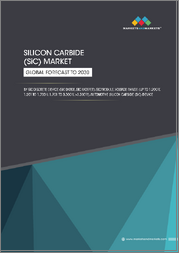
|
시장보고서
상품코드
1609858
일본의 탄화규소(SiC) 시장 보고서 : 제품, 용도, 지역별(2025-2033년)Japan Silicon Carbide Market Report by Product (Black Silicon Carbide, Green Silicon Carbide, and Others), Application (Steel, Automotive, Aerospace, Military and Defense, Electrical and Electronics, Healthcare, and Others), and Region 2025-2033 |
||||||
일본의 탄화규소(SiC) 시장의 시장 규모는 2024년에 5억 620만 달러에 달했습니다. 향후 IMARC Group은 시장이 2033년까지 12억 4,340만 달러에 달하며, 2025-2033년의 성장률(CAGR)은 10.5%에 달할 것으로 예측하고 있습니다. 웨이퍼 사이즈의 대형화나 결정 품질의 향상 등 탄화규소(SiC) 제조 프로세스의 개선이 진행되며, 제조 비용의 삭감이나 가용성의 향상이 시장을 촉진하고 있습니다.
본 리포트에서 답변하는 주요 질문
- 일본의 탄화규소(SiC) 시장의 지금까지 실적과 향후 실적은?
- 일본의 탄화규소(SiC) 시장에 COVID-19가 미친 영향은?
- 일본의 탄화규소(SiC) 시장의 제품별 내역은?
- 일본의 탄화규소(SiC) 시장의 용도별 내역은?
- 일본의 탄화규소(SiC) 시장의 밸류체인에는 어떤 단계가 있는가?
- 일본의 탄화규소(SiC)의 주요 촉진요인과 과제는?
- 일본의 탄화규소(SiC) 시장의 구조와 주요 기업은?
- 일본의 탄화규소(SiC) 시장에서 경쟁의 정도는?
목차
제1장 서문
제2장 조사 범위와 조사 방법
- 조사의 목적
- 이해관계자
- 데이터 소스
- 시장 추정
- 조사 방법
제3장 개요
제4장 일본의 탄화규소(SiC) 시장 : 서론
- 개요
- 시장 역학
- 업계 동향
- 경쟁 정보
제5장 일본의 탄화규소(SiC) 시장 구도
- 과거 및 현재 시장 동향(2019-2024년)
- 시장 예측(2025-2033)
제6장 일본의 탄화규소(SiC) 시장 : 제품별 내역
- 블랙 실리콘 카바이드
- 그린 실리콘 카바이드
- 기타
제7장 일본의 탄화규소(SiC) 시장 : 용도별 내역
- 강철
- 자동차
- 항공우주
- 군과 방위
- 전기·전자
- 헬스케어
- 기타
제8장 일본의 탄화규소(SiC) 시장 : 경쟁 구도
- 개요
- 시장 구조
- 시장 기업 포지셔닝
- 주요 성공 전략
- 경쟁 대시보드
- 기업 평가 상한
제9장 주요 기업의 개요
제10장 일본의 탄화규소(SiC) 시장 : 업계 분석
- 촉진요인·억제요인·기회
- Porter's Five Forces 분석
- 밸류체인 분석
제11장 부록
KSA 24.12.24Japan silicon carbide market size reached USD 506.2 Million in 2024. Looking forward, IMARC Group expects the market to reach USD 1,243.4 Million by 2033, exhibiting a growth rate (CAGR) of 10.5% during 2025-2033. The increasing improvements in silicon carbide manufacturing processes, such as larger wafer sizes and higher-quality crystals, which have reduced production costs and enhanced availability, are driving the market.
Silicon carbide (SiC) is a compound composed of silicon (Si) and carbon (C) atoms arranged in a crystal lattice structure. It is known for its exceptional properties, making it a valuable material in various applications. SiC is extremely hard and exhibits excellent thermal conductivity, even at high temperatures. Its wide bandgap semiconductor properties make it suitable for use in high-power electronic devices, such as power transistors and diodes. SiC has a high melting point and is chemically inert, making it resistant to corrosion. This makes it ideal for use in harsh environments, including in the manufacturing of abrasive tools, cutting tools, and ceramic materials. In addition to its mechanical and thermal properties, SiC also has excellent electrical conductivity, which is crucial in power electronics and semiconductor devices. SiC is gaining popularity in the automotive industry for its use in electric vehicle power electronics, as it can handle high temperatures and high voltage conditions efficiently. It also has potential applications in renewable energy systems, such as solar inverters and wind turbine converters, due to its ability to improve energy conversion and reduce energy losses.
Japan Silicon Carbide Market Trends:
The silicon carbide market in Japan is propelled by a confluence of factors that underscore its burgeoning demand and significance across various industries. Firstly, its remarkable thermal conductivity and superior material properties make it a prime choice for power electronics and semiconductors. Consequently, SiC's ability to enhance energy efficiency and reduce greenhouse gas emissions has fueled its adoption in electric vehicles and renewable energy systems. Furthermore, SiC's exceptional resistance to high temperatures and corrosive environments has amplified its utilization in industrial applications, such as metallurgy and aerospace. In addition to this, its role in the manufacturing of abrasive materials, like cutting tools and grinding wheels, continues to drive growth in the abrasive industry. Moreover, the ongoing trend towards miniaturization of electronic devices and the need for faster, more efficient data processing is expected to drive the silicon carbide market in Japan during the forecast period.
Japan Silicon Carbide Market Segmentation:
Product Insights:
- Black Silicon Carbide
- Green Silicon Carbide
- Others
Application Insights:
- Steel
- Automotive
- Aerospace
- Military and Defense
- Electrical and Electronics
- Healthcare
- Others
- A detailed breakup and analysis of the market based on the application have also been provided in the report. This includes steel, automotive, aerospace, military and defense, electrical and electronics, healthcare, and others.
Competitive Landscape:
The market research report has also provided a comprehensive analysis of the competitive landscape in the market. Competitive analysis such as market structure, key player positioning, top winning strategies, competitive dashboard, and company evaluation quadrant has been covered in the report. Also, detailed profiles of all major companies have been provided.
Key Questions Answered in This Report:
- How has the Japan silicon carbide market performed so far and how will it perform in the coming years?
- What has been the impact of COVID-19 on the Japan silicon carbide market?
- What is the breakup of the Japan silicon carbide market on the basis of product?
- What is the breakup of the Japan silicon carbide market on the basis of application?
- What are the various stages in the value chain of the Japan silicon carbide market?
- What are the key driving factors and challenges in the Japan silicon carbide?
- What is the structure of the Japan silicon carbide market and who are the key players?
- What is the degree of competition in the Japan silicon carbide market?
Table of Contents
1 Preface
2 Scope and Methodology
- 2.1 Objectives of the Study
- 2.2 Stakeholders
- 2.3 Data Sources
- 2.3.1 Primary Sources
- 2.3.2 Secondary Sources
- 2.4 Market Estimation
- 2.4.1 Bottom-Up Approach
- 2.4.2 Top-Down Approach
- 2.5 Forecasting Methodology
3 Executive Summary
4 Japan Silicon Carbide Market - Introduction
- 4.1 Overview
- 4.2 Market Dynamics
- 4.3 Industry Trends
- 4.4 Competitive Intelligence
5 Japan Silicon Carbide Market Landscape
- 5.1 Historical and Current Market Trends (2019-2024)
- 5.2 Market Forecast (2025-2033)
6 Japan Silicon Carbide Market - Breakup by Product
- 6.1 Black Silicon Carbide
- 6.1.1 Overview
- 6.1.2 Historical and Current Market Trends (2019-2024)
- 6.1.3 Market Forecast (2025-2033)
- 6.2 Green Silicon Carbide
- 6.2.1 Overview
- 6.2.2 Historical and Current Market Trends (2019-2024)
- 6.2.3 Market Forecast (2025-2033)
- 6.3 Others
- 6.3.1 Historical and Current Market Trends (2019-2024)
- 6.3.2 Market Forecast (2025-2033)
7 Japan Silicon Carbide Market - Breakup by Application
- 7.1 Steel
- 7.1.1 Overview
- 7.1.2 Historical and Current Market Trends (2019-2024)
- 7.1.3 Market Forecast (2025-2033)
- 7.2 Automotive
- 7.2.1 Overview
- 7.2.2 Historical and Current Market Trends (2019-2024)
- 7.2.3 Market Forecast (2025-2033)
- 7.3 Aerospace
- 7.3.1 Overview
- 7.3.2 Historical and Current Market Trends (2019-2024)
- 7.3.3 Market Forecast (2025-2033)
- 7.4 Military and Defense
- 7.4.1 Overview
- 7.4.2 Historical and Current Market Trends (2019-2024)
- 7.4.3 Market Forecast (2025-2033)
- 7.5 Electrical and Electronics
- 7.5.1 Overview
- 7.5.2 Historical and Current Market Trends (2019-2024)
- 7.5.3 Market Forecast (2025-2033)
- 7.6 Healthcare
- 7.6.1 Overview
- 7.6.2 Historical and Current Market Trends (2019-2024)
- 7.6.3 Market Forecast (2025-2033)
- 7.7 Others
- 7.7.1 Historical and Current Market Trends (2019-2024)
- 7.7.2 Market Forecast (2025-2033)
8 Japan Silicon Carbide Market - Competitive Landscape
- 8.1 Overview
- 8.2 Market Structure
- 8.3 Market Player Positioning
- 8.4 Top Winning Strategies
- 8.5 Competitive Dashboard
- 8.6 Company Evaluation Quadrant
9 Profiles of Key Players
- 9.1 Company A
- 9.1.1 Business Overview
- 9.1.2 Product Portfolio
- 9.1.3 Business Strategies
- 9.1.4 SWOT Analysis
- 9.1.5 Major News and Events
- 9.2 Company B
- 9.2.1 Business Overview
- 9.2.2 Product Portfolio
- 9.2.3 Business Strategies
- 9.2.4 SWOT Analysis
- 9.2.5 Major News and Events
- 9.3 Company C
- 9.3.1 Business Overview
- 9.3.2 Product Portfolio
- 9.3.3 Business Strategies
- 9.3.4 SWOT Analysis
- 9.3.5 Major News and Events
- 9.4 Company D
- 9.4.1 Business Overview
- 9.4.2 Product Portfolio
- 9.4.3 Business Strategies
- 9.4.4 SWOT Analysis
- 9.4.5 Major News and Events
- 9.5 Company E
- 9.5.1 Business Overview
- 9.5.2 Product Portfolio
- 9.5.3 Business Strategies
- 9.5.4 SWOT Analysis
- 9.5.5 Major News and Events
10 Japan Silicon Carbide Market - Industry Analysis
- 10.1 Drivers, Restraints, and Opportunities
- 10.1.1 Overview
- 10.1.2 Drivers
- 10.1.3 Restraints
- 10.1.4 Opportunities
- 10.2 Porters Five Forces Analysis
- 10.2.1 Overview
- 10.2.2 Bargaining Power of Buyers
- 10.2.3 Bargaining Power of Suppliers
- 10.2.4 Degree of Competition
- 10.2.5 Threat of New Entrants
- 10.2.6 Threat of Substitutes
- 10.3 Value Chain Analysis



















